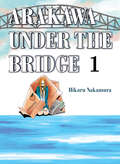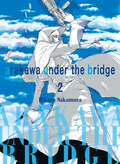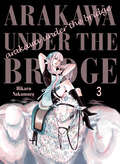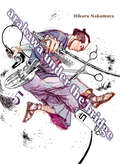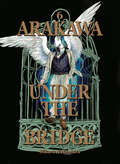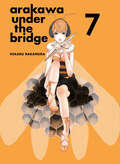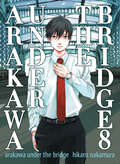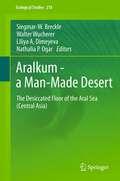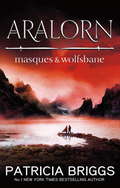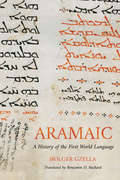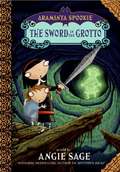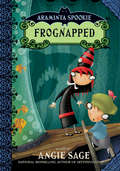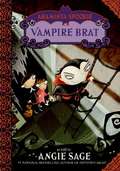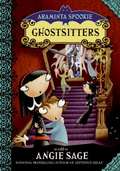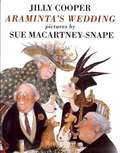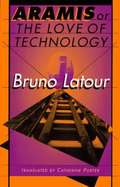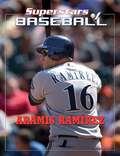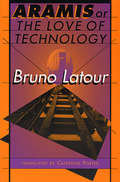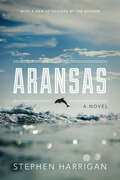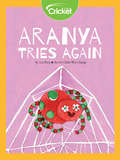- Table View
- List View
Arakawa Under the Bridge 1 (Arakawa Under the Bridge #1)
by Hikaru Nakamura&“Could you help me fall in love?&” Kou Ichinomiya, a young man born with a silver spoon in his mouth and raised with the mantra &“never owe anyone&” suddenly finds himself deeply indebted to a young homeless woman, Nino, who lives on the Arakawa river bank and claims to originally be from the planet Venus. When Nino rejects all of Kou&’s mundane offers of money or housing, Kou is at a loss for how to repay his debt, until Nino suddenly asks him to teach her about love. A daunting task, but the over-achieving Kou is determined to return Nino&’s favor. And so begins Kou&’s life under the bridge, along with a band of eccentric characters who have formed their own little community outside the boundaries of typical Tokyoite life…
Arakawa Under the Bridge 2 (Arakawa Under the Bridge #2)
by Hikaru NakamuraBest-selling mangaka Hikaru Nakamura (Saint Young Men) makes her English language debut with this surreal comedy starring a 620-year-old water sprite, a man with a star for a head, a nun, and a samurai who runs a barber shop under Tokyo's Arakawa Bridge. Part 2 contains volumes 3 and 4 of the Japanese edition.Rec, insulted by the insinuation that he has nothing to contribute to the community under the bridge, decides to start a school. Rec&’s secretaries from his company in the outside world investigate his current situation, reports of which are sent back to his father, who then targets the river bank for redevelopment, threatening the idyllic lifestyle of the river bank denizens...
Arakawa Under the Bridge 3 (Arakawa Under the Bridge #3)
by Hikaru NakamuraBest-selling mangaka Hikaru Nakamura (Saint Young Men) makes her English language debut with this surreal comedy starring a 620-year-old water sprite, a man with a star for a head, a nun, and a samurai who runs a barber shop under Tokyo's Arakawa Bridge. Part 3 contains volumes 5 and 6 of the Japanese edition.&“Nino, I promise that I can accept everything about you!&” Rec calls out when he discovers Nino&’s secret trove of cassette tapes. Rec and Nino are both clumsy when it comes to communication, which leads to situations both humorous and heartbreaking. Once in a while a sombre mood falls upon the river bank under the bridge... until the next absurd turn of events comes around.
Arakawa Under the Bridge 4 (Arakawa Under the Bridge #4)
by Hikaru NakamuraBest-selling mangaka Hikaru Nakamura (Saint Young Men) makes her English language debut with this surreal comedy starring a 620-year-old water sprite, a man with a star for a head, a nun, and a samurai who runs a barber shop under Tokyo's Arakawa Bridge. &“Let&’s go to Venus!&”And so the river bank denizens begin training that will let them go to Nino&’s extraterrestrial hometown. But do any of them have what it takes to make it in space? A trip upstream brings Rec into contact with a tribe ruled by an Amazoness, who soon sees Nino as her rival. Everyone helps build a house for the Mayor and a park for the Metal Brothers. As the cast of characters expands daily life on the river bank becomes ever more eventful…
Arakawa Under the Bridge 5 (Arakawa Under the Bridge #5)
by Hikaru NakamuraBest-selling mangaka Hikaru Nakamura (Saint Young Men) makes her English language debut with this surreal comedy starring a 620-year-old water sprite, a man with a star for a head, a nun, and a samurai who runs a barber shop under Tokyo's Arakawa Bridge. Part 5 contains volumes 9 and 10 of the Japanese edition. The aura of craziness emanating from the Arakawa river bank keeps luring in those who want to fly their own freak flag, including, of all people, Rec&’s secretary Shimazaki. As the day of the launch to Venus, Nino&’s home planet, draws ever closer, everyone must make their preparations and say farewell to those who are earth-bound. Will the rocket, filled with the hopes of its crew, be able to make the interplanetary journey…?
Arakawa Under the Bridge 6 (Arakawa Under the Bridge #6)
by Hikaru NakamuraBest-selling mangaka Hikaru Nakamura (Saint Young Men) makes her English language debut with this surreal comedy starring a 620-year-old water sprite, a man with a star for a head, a nun, and a samurai who runs a barber shop under Tokyo's Arakawa Bridge. Part 6 contains volumes 11 and 12 of the Japanese edition. The Venus-bound rocket successfully launched against all odds… and now Rec is back after an out-of-this-world encounter with Nino&’s folks, and even Takai had his own alien encounter that leaves him transformed. As the seasons turn, everyone&’s eccentricities spiral out and twine together, and the Mayor finds himself expecting…!
Arakawa Under the Bridge 7 (Arakawa Under the Bridge #7)
by Hikaru NakamuraBest-selling mangaka Hikaru Nakamura (Saint Young Men) makes her English language debut with this surreal comedy starring a 620-year-old water sprite, a man with a star for a head, a nun, and a samurai who runs a barber shop under Tokyo's Arakawa Bridge. Part 7 contains volumes 13 and 14 of the Japanese edition. Under the waters of the Arakawa lies the Kapa House. Under the Kapa House is a secret room only those dubbed &“mayor&” are allowed to enter. Inside the room someone casts charms to protect the Arakawa river bank from unwanted intruders...
Arakawa Under the Bridge 8 (Arakawa Under the Bridge #8)
by Hikaru NakamuraBest-selling mangaka Hikaru Nakamura (Saint Young Men) makes her English language debut with this surreal comedy starring a 620-year-old water sprite, a man with a star for a head, a nun, and a samurai who runs a barber shop under Tokyo's Arakawa Bridge. The heartwarming romantic antics of the river bank denizens–both human and alien–draw to a close in this final volume. Shadowy incidents in the past are brought to light, and each character takes a fateful step towards the future. Nino finally ventures outside, yet is foiled by fowl... Rec goes after her, even though the risk of literal heartbreak is real. Join the gang under the bridge for one last hurrah!
Aralkum - a Man-Made Desert: The Desiccated Floor of the Aral Sea (Central Asia) (Ecological Studies #218)
by Siegmar-W. Breckle Liliya A. Dimeyeva Nathalia P. Ogar Walter WuchererHaving been the fourth largest lake on the globe roughly 50 years ago, today the Aral Sea no longer exists. Human activities caused its desiccation and the formation of a huge new desert, the Aralkum, which can be regarded as one of the greatest ecological catastrophes and - at the same time - the largest primary succession experiment of mankind. This volume brings together the results of international and interdisciplinary long-term studies on the new desert ecosystem and is divided into four main sections. The first section provides an overview of the physical characteristics of the area and covers geological, pedological, geomorphological and climatological aspects and their dynamics, especially dust-storm dynamics. The second focuses on the biotic aspects and highlights the spatial and temporal patterns of the flora and fauna. In the third section studies and projects aiming to combat desertification by phytomelioration and to develop strategies for the conservation of biodiversity are presented. The book is rounded off with a section providing a synthesis and conclusions.
Aralorn: Masques and Wolfsbane
by Patricia BriggsA breathtaking epic fantasy adventure from the bestselling Patricia Briggs, author of the Mercy Thompson novels.After an upbringing of proper behaviour and oppressive expectations, Aralorn fled her noble birthright for a life of adventure as a mercenary spy. But her latest mission involves more peril than she ever imagined.Agents of Sianim have asked her to gather intelligence on the increasingly popular and powerful sorcerer Geoffrey ae'Magi. Soon Aralorn comes to see past the man's striking charisma - and into a soul as corrupt and black as endless night. And few have the will to resist the sinister might of the ae'Magi and his minions.So Aralorn, aided by her enigmatic companion, Wolf, joins the rebellion against the ae'Magi. But in a war against a foe armed with the power of illusion, how do you know who the true enemy is - or where he will strike next?This omnibus edition contains the two titles MASQUES and WOLFSBANE.Books by Patricia Briggs:Books three and four in the Sianim seriesSteal the DragonWhen Demons WalkHurogDragon BonesDragon BloodRaven duologyRaven's ShadowRaven's StrikeMercy ThompsonMoon CalledBlood Bound Iron KissedBone CrossedSilver MarkedFrost BurnedNight BrokenFire TouchedSilence FallenStorm CursedSmoke BittenAlpha and OmegaAlpha & OmegaCry WolfHunting GroundFair GameDead HeatBurn Bright
Aramaic: A History of the First World Language (Handbook Of Oriental Studies. Section 1 The Near And Middle East Ser. #111)
by Holger GzellaIn this volume—the first complete history of Aramaic from its origins to the present day—Holger Gzella provides an accessible overview of the language perhaps most well known for being spoken by Jesus of Nazareth. Gzella, one of the world&’s foremost Aramaicists, begins with the earliest evidence of Aramaic in inscriptions from the beginning of the first millennium BCE, then traces its emergence as the first world language when it became the administrative tongue of the great ancient Near Eastern empires. He also pays due diligence to the sacred role of Aramaic within Judaism, its place in the Islamic world, and its contact with other regional languages, before concluding with a glimpse into modern uses of Aramaic. Although Aramaic never had a unified political or cultural context in which to gain traction, it nevertheless flourished in the Middle East for an extensive period, allowing for widespread cultural exchange between diverse groups of people. In tracing the historical thread of the Aramaic language, readers can also gain a stronger understanding of the rise and fall of civilizations, religions, and cultures in that region over the course of three millennia. Aramaic: A History of the First World Language is visually supplemented by maps, charts, and other images for an immersive reading experience, providing scholars and casual readers alike with an engaging overview of one of the most consequential world languages in history.
Araminta Spookie 1: My Haunted House
by Angie Sage Jimmy PickeringAraminta Spookie lives in a wonderful old haunted house, but her crabby aunt Tabby wants to move. Aunt Tabby is determined to sell their house-Araminta has to stop her!<P> With the help of a haunted suit of armor named Sir Horace, a ghost named Edmund, and a lot of imagination, Araminta hatches a plot for an Awful Ambush that is so ghoulish, it just might work!<P> Advisory: Bookshare has learned that this book offers only partial accessibility. We have kept it in the collection because it is useful for some of our members. To explore further access options with us, please contact us through the Book Quality link on the right sidebar. Benetech is actively working on projects to improve accessibility issues such as these.
Araminta Spookie 2: The Sword in the Grotto
by Angie Sage Jimmy PickeringSir Horace is about to turn five hundred years old! Araminta and Wanda need to find him the perfect gift. Araminta finds an ancient sword in a grotto hidden under her haunted house-and it should be a cinch to get it. But she wasn't planning on the nasty surprise of a portcullis-trap and a rising tide in the grotto. Will Araminta and Wanda make it to Sir Horace's birthday party?
Araminta Spookie 3: Frognapped
by Angie Sage Jimmy PickeringWhen something's amiss in Spookie House, there's usually only one person to blame-Araminta. But this time she had nothing to do with the disappearance of Barry Wizzard's frogs, and she is determined to find them. Of course, it's not going to be that easy, especially when dealing with a crazy character named Old Morris, a dangerous shark, and a demanding aquarium show audience. Can Araminta find the frogs and steal the show?
Araminta Spookie 3: Frognapped
by Angie Sage Jimmy PickeringWhen something's amiss in Spookie House, there's usually only one person to blame--Araminta. But this time she had nothing to do with the disappearance of Barry Wizzard's frogs, and she is determined to find them. Of course, it's not going to be that easy, especially when dealing with a crazy character named Old Morris, a dangerous shark, and a demanding aquarium show audience. Can Araminta find the frogs and steal the show?
Araminta Spookie 4: Vampire Brat
by Angie Sage Jimmy PickeringAraminta thinks something horrible is hiding in the deep, hidden passages of Spookie House-could it be a werewolf? Add to that the arrival of Uncle Drac's creepy nephew, Max, and Araminta knows things will never be the same. Max is Wanda's new best friend, and Araminta finds him annoying. She comes up with a plan to figure out what Max is up to-and also to capture the werewolf. But will it work?
Araminta Spookie 5: Ghostsitters
by Angie Sage Jimmy PickeringWhen Aunt Tabby and Uncle Drac head off to Transylvania, Araminta is upset-they're going to be away on her birthday. However, when it turns out that her almost-grown-up cousin, Mathilda, will be babysitting, it seems things couldn't get any better. But Mathilda's brought along trouble: two rowdy teenage ghosts, Ned and Jed, who listen to no one. It's a disaster! Can the girls figure out a way to get Ned and Jed out of the house for good?
Araminta Station (Gateway Essentials #196)
by Jack VanceTravel out along the galaxy's Perseid Arm. Branch off to follow the ten thousand stars of Mircea's Wisp. Eventually you will come to the Purple Rose System - three stars, Lorca, Sing and Syrene, that seem about to drift away into the void. Three planets circle Syrene. On one, Cadwal, there is Life. Long ago the Naturalist Society of Earth had listed Cadwal as a natural preserve. An administration centre had been set up and staffed to protect the planet from all exploitation. Araminta Station. Now, centuries later, the young Glawen Clattuc is beginning to wonder what the future may hold for him in the hierarchic, carefully ordered hereditary society that is life on Cadwal.
Araminta's Wedding
by Jilly Cooper OBEA Country House Extravaganza Story by Jilly Cooper. Pictures by Sue Macartney-Snape.Rufus, fifth Earl of Atherstone, has no son and gloomily contemplates his vast Lincolnshire estate passing into the hands of his plain but good-natured daughter, Araminta, and her grasping cousin, Piggy Atherstone, who is determined to marry her. A serious rival for Araminta's hand, however, materialises in Bounder Cartwright, a debonair money-market gambler, whose sexual conquests are as prolific as his investments are suddenly catastrophic. By Ascot he has won the day and the wedding is fixed for September.Then, at the last minute, the events of the previous Boxing Night catch up with the Atherstones in a surprising way. Will the wedding take place or not? The combination of Jilly Cooper's irreverent tale of country house life with the colourful and perceptive paintings of Sue Macartney-Snape which inspired it, presents a wickedly funny portrait of the English upper classes at play. Araminta's Wedding is irresistible fireside reading for even the coldest of stately homes.
Aramis (Or, The Love of Technology)
by Bruno Latour Catherine PorterBruno Latour has written a unique and wonderful tale of a technological dream gone wrong. As the young engineer and professor follow Aramis' trail--conducting interviews, analyzing documents, assessing the evidence--perspectives keep shifting: the truth is revealed as multilayered, unascertainable, comprising an array of possibilities worthy of Rashomon. The reader is eventually led to see the project from the point of view of Aramis, and along the way gains insight into the relationship between human beings and their technological creations. This charming and profound book, part novel and part sociological study, is Latour at his thought-provoking best.
Aramis Ramirez (Superstars of Baseball)
by Tania RodriguezAramis Ramírez is one of the Dominican players who have made it all the way to the top. Today, he's a great third basemen with a smart and powerful batting style. His career so far has been filled with mostly successes. Read how Ramírez made it big even as the MLB's youngest player. Follow his story from the minor leagues to his latest moves.
Aramis, or the Love of Technology
by Bruno LatourBruno Latour has written a unique and wonderful tale of a technological dream gone wrong. As the young engineer and professor follow Aramis' trail--conducting interviews, analyzing documents, assessing the evidence--perspectives keep shifting: the truth is revealed as multilayered, unascertainable, comprising an array of possibilities worthy of Rashomon. The reader is eventually led to see the project from the point of view of Aramis, and along the way gains insight into the relationship between human beings and their technological creations. This charming and profound book, part novel and part sociological study, is Latour at his thought-provoking best.
Aransas: A Novel
by Stephen Harrigan&“Beneath the genial surface&” of this &“resonant&” first novel about a dolphin trainer who struggles with the ethics of his job &“allusive undercurrents tug&” (The New York Times Book Review). A critically acclaimed debut novel first published in 1980, Aransas recounts a young man&’s homecoming to his small Gulf Coast fishing town of Port Aransas. As Jeff Downing begins work training two porpoises to become part of a tourist attraction, he comes to love them as well as the woman who wants to release the pair to the wild. &“The sureness and poise of this first novel are as remarkable as the sharpness, oddity, and clarity of its feelings.&” ―Newsweek &“Harrigan&’s eye for locale and its effect is superb.&” —Washington Post Book World &“Harrigan . . . Has a sharp eye for observing man, beast, seashore, and town in a vividly drawn setting.&” ―Publishers Weekly &“An ardent and elegant book, beautiful in its language, mature in its perceptions, noble in its sentiments.&” ―San Francisco Chronicle &“Sensitive [and] enormously evocative first . . . Spare but warm prose . . . Immerses us in atmosphere as insistently as it does the plot . . . Harrigan is a splendid novelist.&” —Houston Post &“Aransas has several surprises, including dramatic suspense, counterculture revisionism, and what must be considered dolphin revisionism. More, Harrigan has written an acute American regional novel.&” —The Village Voice
Arapaho
by Barbara A. Gray-KanatiioshEasy-to-read text and colorful illustrations and photos teach readers about Arapaho history, traditions, and modern life. This book describes society and family structure, hunting and gathering methods, and ceremonies and rituals. Readers will learn about Arapaho clothing, as well as crafts such as quillwork and beadwork. A traditional myth is included, as is a description of famous Arapaho leader Niwot. Wars, weapons, and contact with Europeans are discussed. Topics including European influence, assimilation, reservations, and federal recognition are also addressed. In addition, modern Arapaho culture and still-celebrated traditions such as the sun dance ceremony are introduced. Arapaho homelands are illustrated with a detailed map of the United States, and a step-by-step illustration of tepee construction shows readers how the Arapaho built their homes. Bold glossary terms and an index accompany engaging text. This book is written and illustrated by Native Americans, providing authentic perspectives of the Arapaho.
